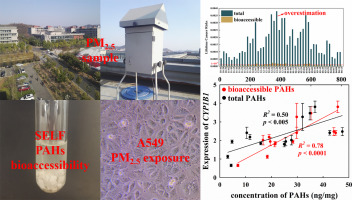Science of the Total Environment ( IF 8.2 ) Pub Date : 2018-08-21 , DOI: 10.1016/j.scitotenv.2018.08.246 Yunzi Li , Albert L. Juhasz , Lena Q. Ma , Xinyi Cui

|
In this study, 46 PM2.5 samples collected from Nanjing, China were analyzed for total PAH concentration, with 14 samples assessed for PAH inhalation bioaccessibility and dioxin toxicity. The concentration of 19 PAH compounds in PM2.5 ranged from 4.03 to 102 ng m−3. When PAH inhalation bioaccessibility was assessed using simulated epithelial lung fluid, mean bioaccessibility values ranged from 3.21% (Benzo(c)fluorene) to 44.2% (Acenaphthylene). Benzo(a)pyrene concentration in 50% of the PM2.5 samples exceeded the Chinese air quality standard of 2.5 ng m−3, however, when bioaccessibility was considered, all samples were below the criterion. Similarly, the cancer risk probability for all PM2.5 samples was >10−4 incidences on the basis of total PAH concentration, while only 37% of samples posed a risk >10−4 after incorporation of bioaccessibility. Dioxin toxicity of PM2.5-bound PAHs was also investigated by characterizing mRNA expression of cytochrome P450 superfamily members in human lung cells (A549 cell). Compared to total PAH concentration, the use of bioaccessible concentration was better at predicting dioxin toxicity of PM2.5-associated PAHs (correlation coefficient R2 = 0.40–0.83 with p < 0.05). This study indicates that PAH inhalation bioaccessibility is an important consideration when assessing and predicting the risk posed by PM2.5 particles, which is particularly important for countries with deteriorating air quality.











































 京公网安备 11010802027423号
京公网安备 11010802027423号